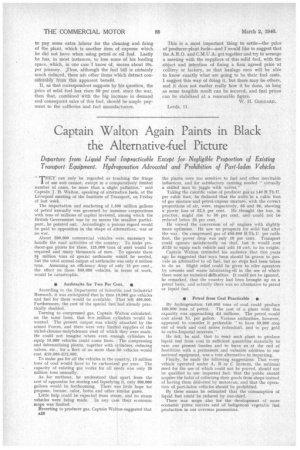Captain Walton Again Paints in Black the Alternative-fuel Picture
Page 36

If you've noticed an error in this article please click here to report it so we can fix it.
Departure from Liquid Fuel Impracticable Except for Negligible Proportion of Existing Transport Equipment. Hydrogenation Advocated and Prohibition of Part-laden Vehicles
'THEY can only be regarded as touching the fringe 1 of use and cannot, except in a comparatively limited number of cases, be more than a slight palliative," said Captain J. B. Walton, speaking of alternative fuels, at the Liverpool meeting of the Institute of Transport, on Friday of last week.
The importation and marketing of 1,500 million gallons of petrol annually was governed by immense corporations with tens of millions of capital invested, among which the British Government was by no means the smallest participant, he pointed out. Accordingly a jealous regard would be paid to opposition in the shape of alternatives, war or no war.
About 500,000 commercial vehicles were necessary to handle the road activities of the country. To make producer-gas plants for these, 125,000 tons of steel would be required and many thousands of men. To operate them 3* million tons of special anthracite would be needed, but the total annual output of anthracite was only 6 million tons. Assuming an efficiency drop of only 13 per cent., the effect on those 500,000 vehicles, in terms of work, would be catastrophic.
• Anthracite for Two Per Cent. 4,
According to the Department of Scientific and Industrial Research, it was anticipated that in time 10,000 gas vehicles and fuel for them would be available. That left 490,000. Furthermore, the cost of the special fuel had already practically doubled, Turning to compressed gas, Captain Walton calculated, on the same basis, that five million cylinders would be wanted. The present output was wholly absorbed by the armed Forces, and there were very limited supplies of the nickel-chrome-molybdenum steel of which they were made. He could not imagine where even enough cylinders to equip 10,000 vehicles could come from. The compressing and debenzolizing plants, together with cylinders, reducing valves, etc., for a fleet of no more than 50 vehicles would cost £10,000-£12,000.
To make gas for all the vehicles in the country, 15 million tons of coal would have to be carbonized per year The capacity of existing gas works for all needs was only 20 million tons annually.
As for methane, he understood that apart from the cost of apparatus for storing and liquefying it, only 300,000 gallons would be forthcoming. There was little hope for propane, butane, calor, botto and other similar gases.
Little help could be expected from steam, and no steam vehicles were being made. In any case their economic scope was limited.
Reverting to producer gas, Captain Walton suggested that .a26 the plants were too sensitive to fuel and other inevitable influences, and for satisfactory running needed " virtually a skilled man to juggle with valves."
Taking the Calorific value of producer gas as 140 B.Th.LT. per cubic foot, he deduced that the units in a cubic foot of gas mixture and petrol-vapour mixture, with the correct proportions of air, were, respectively, 65 and 96, showing a' power loss of 32.5 per cent. He thought the loss, in practice, might rise to 50 per cent. and could not be reduced below 20 per cent.
He viewed the conversion' of oil engines with slightly more optimism. He saw no prospects for solid fuel after the war. On compressed gas of 450-500 B.Th.tI. per cubic foot, the power drop was only 10 per cent. Transport could operate satisfactorily on that, but it would cost £125 to equip each vehicle and add 10 cwt. to its weight.
Captain Walton reminded his audience that two years ago he suggested that soya bean should be grown to provide an alternative to oil fuel, but no steps had been taken to do so. Slight relief could be given to oiler operators by creosote and waste lubricating oil in the use of which there were no technical difficulties. It could not be ignored, he remarked, that the country had been brought up on a petrol basis, and actually there was no alternative to petrol or liquid fuel.
• Petrol from Coal Practicable • By hydrogenation 146,000 tons of coal could produce 100,000 tons of petrol. The cost of a plant with this capacity was approaching £4 Millions. The petrol would cost about 7d. per gallon. Various authorities, however, appeared to consider it preferable "to have 50,000 men out of work and coal mines redundant, and to pay gold to extra-Imperial interests," He felt, he said, that to erect such plant to produce liquid fuel from coal in sufficient quantities materially to ease our present burden and to leave us at the end of hostilities with a permanent and valuable addition to our national equipment, was a true alternative to importing.
Finally, he made the following suggestions: That every vehicle operated under A, B or C licences, the national need for the use of which could not be proved, should not be qualified to use imported fuel; that the public should acquire the habit of collecting their goods from shops instead of having them delivered by motorvan,-and that the operation of part-laden vehicles should be prohibited.
By these means he estimated that the consumption of liquid fuel could be reduced by one-third.
There was scope also for the development of more economic prime movers and of indigenous vegetable fuel production• in our overseas possessions.




































































